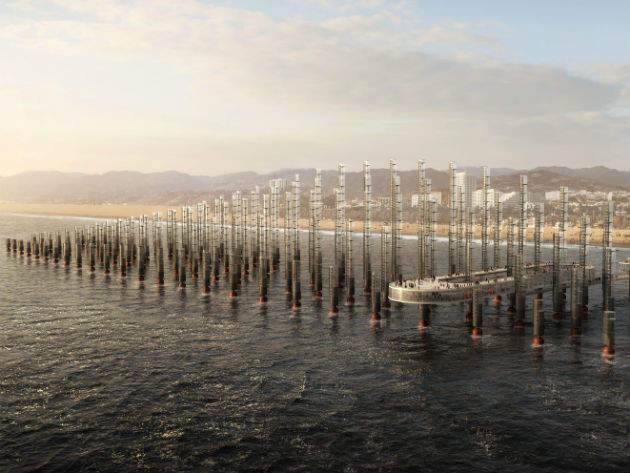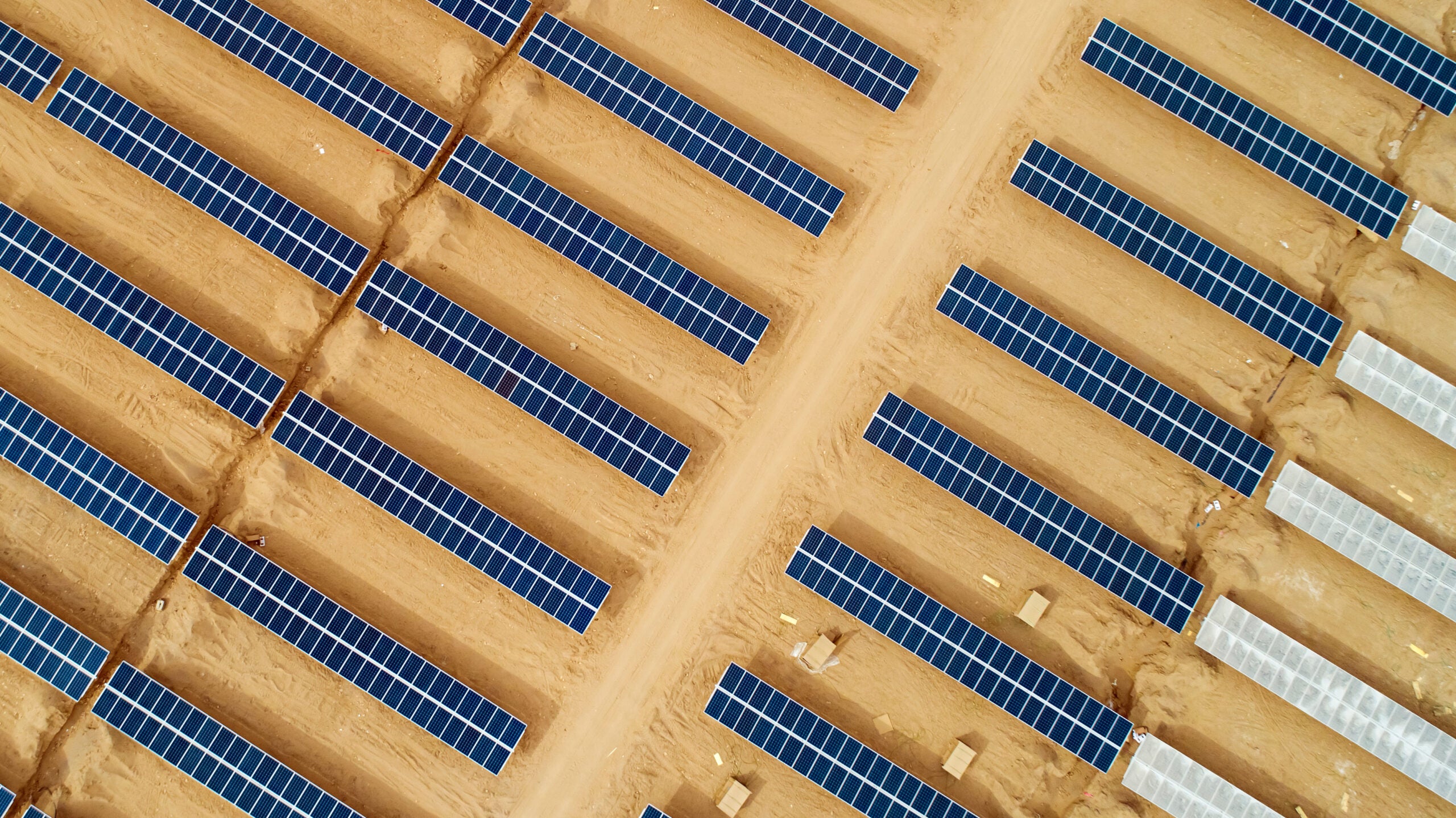
 For years, a common criticism of renewable energy has been the negative visual impact of structures, be it wind turbines, photovoltaics or others. However, British architectural company BDLA has teamed up with specialist environmental engineering company XCO2 to design a statuesque new source of power for Santa Monica in California.
For years, a common criticism of renewable energy has been the negative visual impact of structures, be it wind turbines, photovoltaics or others. However, British architectural company BDLA has teamed up with specialist environmental engineering company XCO2 to design a statuesque new source of power for Santa Monica in California.
“It was a competition entry, for which we came in the top ten out of 960 entrants from around the world,” explains BDLA Architects director John Perry. “We considered how best to meet the brief which was to demonstrate the power of energy saving solar collect, wave power and so on, and we infused those ideas together to produce the design that we have.”
How well do you really know your competitors?
Access the most comprehensive Company Profiles on the market, powered by GlobalData. Save hours of research. Gain competitive edge.

Thank you!
Your download email will arrive shortly
Not ready to buy yet? Download a free sample
We are confident about the unique quality of our Company Profiles. However, we want you to make the most beneficial decision for your business, so we offer a free sample that you can download by submitting the below form
By GlobalDataMaking power technology attractive
 The entry was for the 2016 Land Art Generator Initiative (LAGI), which seeks to make renewable energy beautiful and each year chooses a new location for the designs. BDLA says that the design was tailored for the Californian coast. “For Santa Monica it's great, it's a bright, vibrant place, it's a big coastline there, with a lot of hills and mountains in land,” says Perry. “So it's a big space, and it can take that sort of manmade intervention. It's like a piece of sculpture, a working piece of sculpture.”
The entry was for the 2016 Land Art Generator Initiative (LAGI), which seeks to make renewable energy beautiful and each year chooses a new location for the designs. BDLA says that the design was tailored for the Californian coast. “For Santa Monica it's great, it's a bright, vibrant place, it's a big coastline there, with a lot of hills and mountains in land,” says Perry. “So it's a big space, and it can take that sort of manmade intervention. It's like a piece of sculpture, a working piece of sculpture.”
In order to ensure the greatest potential energy benefits, BDLA turned to XCO2. “XCO2 are an exciting and forward looking consultancy keenly looking at carbon reduction and energy efficiency,” explains Perry. “Their participation made the competition design an intellectually stimulating and enjoyable process for my team at BLDA.”
 The Sun Towers works in three ways, using solar and wave technology to create energy, but also providing fresh water. If installed in Santa Monica, the towers would produce 4,000MWh of power, along with 110 million litres of drinking water a year.
The Sun Towers works in three ways, using solar and wave technology to create energy, but also providing fresh water. If installed in Santa Monica, the towers would produce 4,000MWh of power, along with 110 million litres of drinking water a year.
Sun Towers would work in fields of units; each unit is a micro plant which rises from the sea as a mast. They are made of steel and glass, and contain a stack of water vessels.
The masts are covered in photovoltaic panels and solar power is the predominant source of energy within the units. Excess solar power is used to run a micro desalination plant at the bottom of the masts, which use reverse osmosis to create safe, fresh water which is transported along with the solar electricity back to the mainland for use.
Building beautiful structures
 Along with solar power, Sun Towers also contain a wave converter. Each unit works like a buoy, rising and falling with the sea. BDLA explained: “A contained wave pump system moves up and down in sync with the waves, compressing the seawater until it reaches the solar water vessels. The tallest tower requires the seawater to rise up to 70m-80m. Each tower has a wave pump placed at the base which drives the seawater upwards.”
Along with solar power, Sun Towers also contain a wave converter. Each unit works like a buoy, rising and falling with the sea. BDLA explained: “A contained wave pump system moves up and down in sync with the waves, compressing the seawater until it reaches the solar water vessels. The tallest tower requires the seawater to rise up to 70m-80m. Each tower has a wave pump placed at the base which drives the seawater upwards.”
The multiple sources of power, along with the potential for water desalination would allow this project to make the most of the space. Each tower can produce 33,000KWh of zero carbon electricity a year and, as opposed to horizontal solar panels, this arrangement also ensures that sunlight is still able to reach the water below mitigating any effect to sea life.
 Potentially the most striking aspect of the design is the colour display, with each unit lighting up and changing colour based on the movement of the water around it. Designed by Steven Scott, the opaque masts of the day are transformed at night to mirror the waves that hit the masts, through rising, falling and swelling displays of colour. This shows the power created through the wave technology at night, allowing passers-by to interact with the project.
Potentially the most striking aspect of the design is the colour display, with each unit lighting up and changing colour based on the movement of the water around it. Designed by Steven Scott, the opaque masts of the day are transformed at night to mirror the waves that hit the masts, through rising, falling and swelling displays of colour. This shows the power created through the wave technology at night, allowing passers-by to interact with the project.
Scott played a key role in making the energy processes visual. “We all believe that the result of this team effort, including Steven Scott, is a winner,” says Perry. The units would be able to produce 0.5% of Santa Monica’s energy demands a year, and interact with the more than six million people visit the pier a year.
Striking a balance in technology design
 A key goal of the LAGI is to allow everyday people to engage with energy by encouraging new, unusual and attractive renewable energy designs. “It's our first shot,” says Perry, “I don't think anyone has done anything like this, we scratched our head for some time saying how can we make this really exciting? How can we demonstrate what's going on here?”
A key goal of the LAGI is to allow everyday people to engage with energy by encouraging new, unusual and attractive renewable energy designs. “It's our first shot,” says Perry, “I don't think anyone has done anything like this, we scratched our head for some time saying how can we make this really exciting? How can we demonstrate what's going on here?”
Whilst this design was tailored to Santa Monica, it could be applicable around the world, giving the project a far greater potential for interaction.
“We think the concept is one that given the right sea and heat is widely applicable,” says Perry. “Clearly there's a belt around the globe where that mixture of climate and ocean occurs particularly on the west coast of the states, various areas around the Middle East and the belt round there and also in parts of Asia.”
 Going forward, the team hopes its design will come to fruition in Santa Monica and beyond. The units have been designed in such a way that there is even the possibility of prefabrication, making it easier to adopt.
Going forward, the team hopes its design will come to fruition in Santa Monica and beyond. The units have been designed in such a way that there is even the possibility of prefabrication, making it easier to adopt.
“It’s adaptable and it could be constructed from what I might call a kit of parts, where the parts could be manufactured in one place for use in several around the world,” says Perry.
The striking design helps to prove that energy can be beautiful, interacting with the public and keeping it at the forefront of design as we move to a more sustainable future.




